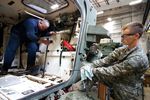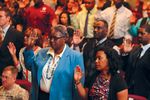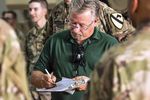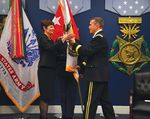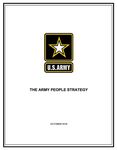One Profession, Two Communities, and the Third Rail We Cannot Ignore - Army ...
←
→
Page content transcription
If your browser does not render page correctly, please read the page content below
One Profession, Two
Communities, and the Third
Rail We Cannot Ignore
Lt. Col. David P. Cavaleri, U.S. Army, Retired
Lt. Col. Davin V. Knolton, PhD, U.S. Army, Retired
A phrase often surfaces during political debate
whereby something is called a “third rail.”
It evokes images of subway car rails, two of
which are inert but the third is electrified, and the saying
describes an issue to avoid if status quo maintenance of
a particular environment is the goal.1 When it comes toTHIRD RAIL
people in the military—how they are acquired, developed Civilians to move into, between, and out of … opportu-
and managed—however, the Army’s position is clear: the nities.”5 The means for accomplishing this is to “trans-
status quo will no longer suffice.2 form our dated approaches to civilian human resources
management and replace them with approaches focused
Transformation Motivation upon talent management.”6
The Army’s motivation to transform its personnel
management practices is found in the 2019 “Army Readiness Lens
People Strategy” (APS): “The Army must remain ready If the Army leverages readiness to assess ACC trans-
as the world’s premier combat force. That readiness (em- formation, it must ask itself what it is ready to do. An easy
phasis added) is strengthened by people who comprise enough question for soldiers: “fight and win the Nation’s
the Total Army Force.”3 The APS then states the Army wars through prompt and sustained land combat, as part
will “shift from simply distributing personnel” to an of the Joint Force.”7 For Army civilians though, it is not so
approach that “more deliberately manage[s] the tal- simple; defining Army civilian readiness at the individual,
ents that … Soldiers and Civilians possess.”4 “The Army
People Strategy-Civilian Implementation Plan” (APS-
CIP) that operationalizes the APS strategic vision across
the Army Civilian Corps (ACC) intends to enable that The third rail at the West Falls Church Metro stop 7 July 2005 in Wash-
ington, D.C. The electrified third rail is at the top of the image, under
shift by “change[ing] our internal culture of civilian
a white cover. The first and second rails are ordinary railroad rails that
human resources management, … [and] instilling a complete the electrical circuit through the trains but are grounded for
new philosophy that facilitates the ability of talented safety. (Photo courtesy of Ancheta Wis via Wikimedia Commons)organizational, and functional levels is actually a specified every definition of what culture is, there is an important
APS-CIP task. The Defense Department definition does contrary view.”12 The APS definition of culture is useful:
not cleanly apply in this context.8 So, absent an approved “The foundational values, beliefs, and behaviors that drive
definition at the time of this writing, the authors leverage an organization’s social environment, and it plays a vital
the following: individual readiness is the multidimen- role in mission accomplishment.”13 Within culture, there is
sional (education, training, certification, experience) room to modernize an Industrial Age workforce manage-
data-driven measure of an individual’s ability to perform ment construct to achieve APS strategic outcomes and
his or her job to full-perfor- APS-CIP civilian talent manage-
mance standards; organizational ment priorities.14
readiness is the multidimensional The “Total Army” consists
(manning and resourcing) as- of two distinct communities of
sessment of its capability to meet practice: the Profession of Arms
its assigned missions; and ACC and the Army Civilian Corps.15
readiness is both the quantifiable Civilians have supported soldiers
and subjective determination of since 1775, initially in critical
its capability to efficiently and departments like quartermas-
effectively manage Secretary of ter, ordnance, transportation
the Army Title 10 functions.9 and medical.16 Today the ACC
When it comes to the ACC, numbers approximately 330,000
Army doctrine is clear: “Soldiers with members serving in over
are the reason for their [Army five hundred occupational
civilians’] service.”10 We trust the series across thirty-two unique
reader sees the readiness “connec- career fields. Each individual
tive tissue” between soldier-Army brings diversity of thought and
mission-ACC. experience based on education,
To view The Army People Strategy, visit https://www. training, and employment in
A Third Rail army.mil/e2/downloads/rv7/the_army_people_strat- the private sector and other
egy_2019_10_11_signed_final.pdf.
That connection notwith- government agencies.17 Today’s
standing, the Army is and will ACC is engaged in a host of
remain significantly challenged to realize its civilian workforce functions never envisioned in the late eighteenth centu-
change strategy until it addresses a principal “third rail” that ry, representing a significant component of the nation’s
affects the spectrum of workforce management practices. The Total Army People Enterprise.18 ACC members provide
third rail has many components so the word “culture” is leadership, stability, and continuity across the gener-
used as an umbrella term. The authors feel strongly about ating force, enabling soldiers to focus on warfighting.
this challenge because they are familiar with the ACC’s Additionally, ACC members deploy overseas as part of
predilection for avoiding what Harvard Law School the expeditionary civilian workforce to support Army
lecturer Douglas Stone and his coauthors call “difficult operational efforts in combat theaters.
conversations.”11
Third Rail Components
Environmental Context Disaggregating this third rail results in compo-
Significant literature exists about organizational nents called “friction between the two Army profes-
culture and climate, and definitions of each and their ap- sion communities of practice,” “friction internal to the
plications vary from macro-views to micro-views. For ex- ACC,” and “friction generated by legacy ACC talent
ample, in their 2013 review of organizational culture and management practices.”
climate research, Benjamin Schneider, Mark G. Ehrhart, Component #1: The first “rail” component, “fric-
and William H. Macey declared, “There is not agree- tion between the two Army profession communities
ment on what culture is nor how it should be studied. For of practice,” reveals itself in how the profession of arms
24 March-April 2021 MILITARY REVIEWTHIRD RAIL
(i.e., soldiers) perceives ACC effectiveness and efficien- Mike Pogue, U.S. Army Tank-Automotive and Armaments Command
cy; how the ACC perceives the profession of arms; and logistics assistance representative, 401st Army Field Support Brigade,
signs an inspection checklist 14 September 2018 after a joint pre-
the differences between the two communities’ manage- ventative maintenance checks and services inspection with soldiers
ment philosophies. While perceptions vary according assigned to the 154th Composite Truck Company-Heavy, 524th
to an individual’s environment, biases, and backgrounds, Combat Sustainment Support Battalion, on a newly rebuilt Heavy
recent interviews of military and civilian leaders revealed Equipment Transporter System (HETS) truck equipped with C-kit
belly-plate armor, or “golden HET,” at an Army Prepositioned Stocks-5
notable underlying trends.19 From 2010 to 2012, the warehouse at Camp Arifjan, Kuwait. (Photo by Justin Graff, 401st Army
Army conducted a learning campaign to understand the Field Support Brigade Public Affairs)
profession of arms and the professional soldier and then
subsequently expanded the effort to examine the role of
the ACC in the profession.
Although the Army expanded the study scope, One senior officer correlated this study to legacy
several former and current senior officers inter- perceptions, for example, that the ACC represented an
viewed stated the study did not seriously consider occupation that is not composed of certified experts who
the ACC; instead, it tried to shoehorn the uniformed continually learn to maintain individual proficiency, as
component, the component’s families, and the ACC opposed to the American professional soldier who is an
into a “one-size-fits-all” box.20 Written declarations expert and volunteer, bonded with comrades by means
like “Army culture is the system of shared meaning of a shared identity and culture of sacrifice and service to
held by its Soldiers, the shared attitudes, values, the Nation. He directly linked this perceived distinction
goals, and practices that characterize the larger to the military evaluation system provision requirement
institution over time” implicitly excluded the ACC, that a uniformed member appear in the rating chain of
despite approximately 55 percent retired military any soldier who is rated or senior rated by an ACC mem-
comprising the membership.21 ber.22 Another interviewee, a former senior officer turned
MILITARY REVIEW March-April 2021 25ACC member, related how, after briefing a visiting gener- J. L. McDonald, a heavy equipment repairer with the Department
al officer, he left personally and professionally frustrated, of the Army, applies leverage with a pry bar 14 March 2017 as Pvt.
Kristopher P. Cole works to attach a chain to the rear access door of
saying, “Yesterday I was a former battalion commander; a Stryker armored vehicle at the Tank-Automotive and Armaments
today I’m a second-class citizen.”23 Command Fleet Management Expansion, Combat Systems Division at
Another friction point concerns how soldiers enjoy Fort Benning, Georgia. (Photo by Staff Sgt. Brian A. Barbour, Arizona
a professional identity based on shared culture, cama- Army National Guard)
raderie, and experience but perceive ACC members as
motivated primarily by something other than altruism.
As one interviewee characterized it, “Many uniformed Conversely, ACC interviewees trended toward a per-
members may feel that because they endure more ception that the uniformed component had neither time
hardship (time in the field, time at work, deployments, nor interest “to learn this [institutional Army] job; I’m
[or] physical training standards), these hardships dis- just here to punch a ticket and get back to the warrior
tinguish their role from those of Civilians. Not only are stuff.”26 There are also perceptions held by both commu-
they different, but I argue that many [Soldiers] believe nities that the ACC does not endorse members adopt-
that their ‘hardship’ incurs more ‘honor’ on their work ing a personal continuous learning regimen, choosing
and person.”24 The same interviewee observed how age instead the “we have always done it that way” approach.
might be a factor associated with this component: “A lot One senior officer noted his ACC workforce members
of the friction emanates from the difference in age de- routinely declined professional or leader development
mographics of the two communities … age plays a sig- opportunities because they “already had that T-shirt”;
nificant role in how these two communities view each consequently, he characterized them as “behind the
other and interact with predictable sources of friction times” and “non-value added.”27 This viewpoint survives
where a younger uniformed member has supervisory because the ACC is divided, one foot gingerly resting in
duties over older [Army] Civilians.”25 the military/Army profession, the other firmly planted
26 March-April 2021 MILITARY REVIEWTHIRD RAIL
in business/government operations. Unsurprisingly, the as the process of attracting, developing, integrat-
foregoing perceptions also create friction with respect to ing, and retaining cycle or acquire, develop, employ,
how the ACC views itself. retain cycle in the APS-CIP human capital lifecycle.31
Component #2: The second “rail” component, “friction A brief review of recent ACC talent management
internal to the ACC,” reveals itself in a number of ways. efforts, specifically the civilian workforce transforma-
One manifestation occurs between ACC managers and tion initiative, will prove helpful.
the multitude of unions that support Army operations; as The 2011 learning campaign referenced above fielded
of this writing, there were 225 collective bargaining agree- three research questions: What does it mean for the
ments in force between the Department of the Army and Army to be a Profession of Arms? What does it mean to
as many as twenty-one distinct unions.28 The following re- be a professional soldier? After nine years of war, how are
flects a trend surfaced during interviews and conversations we as individual professionals and as a profession meeting
with (unofficial) uniformed and ACC component rep- these aspirations?32 Due to deployed force stressors, the
resentatives and unfortunately reinforces the point: “The study understandably focused on the uniformed com-
(ACC) can’t transform its management practices because ponent to identify ethical-behavior-lapse causality, and
the Union(s) won’t change their mindset(s).” When senior insert education and training mitigation measures into
managers do not effectively engage unions, misperceptions Army professional military education and skills certifi-
and the resulting stress cause unnecessary complications. cation systems. It did not, however, examine the impacts
One supervisory Army civilian interviewee described generated of the prolonged conflict on the ACC’s role
frustration while trying to meet a new mission because in the design, generation, support, and application of
a subordinate Army civilian, whose position description
required he “remain current with existing technology,” Lt. Col. David P. Cavaleri, Lt. Col. Davin V. Knolton,
had neither the required skill nor the willingness to attain U.S. Army, retired, is the PhD, U.S. Army, retired,
it. The supervisor requested labor management relations Army University Civilian is the director of the Army
staff assistance with generating an Army civilian’s perfor- Development Integration Aviation Civilian Personnel
mance improvement plan. Unfortunately, the supervisor’s Office program manager. Proponent at Fort Rucker,
frustration only increased when the staff representative He holds a BA from Eastern Alabama. He holds an MS
expressed unwillingness to assist because of the “very Nazarene College and an from Central Michigan
strong union defense and loss of previous similar griev- MA from the University University, an MMAS from
ance actions at that installation.”29 ACC members must of Missouri. As an armor the U.S. Air Force Air War
understand the underpinnings of ACC-union relation- officer, he saw duty on College, and a PhD from
ships sufficiently to engage in meaningful partnership. three continents and in one Kansas State University.
A second internal friction element exists between combat area of operations, During his career, he served
Army civilian professionals and Department of Defense finishing his uniformed with the 1st, 4th, and 8th
contractors. Defense industrial complex contractors exist career as the operations Infantry Divisions and was
to service non-inherently governmental or temporary officer for the U.S. Army a communications officer
mission capability gaps. Because the complex is a prime Battle Command Training on board the National
military experience recruiter, contractors are frequently Program. His Army Civilian Airborne Operations
viewed as headhunters offering a better compensation Corps career includes Center on 11 September
package than what is available to an ACC member service with the Combined 2001. He is a graduate
performing a similar job. One former Army offi- Arms Center G-3/5/7 and of the Department of
cer-turned-contractor said once he became a contractor, the Army Management Defense Senior Leader
uniformed and Army civilian counterparts viewed him as Staff College. He has been Development Program,
“a lower-life form” despite previously serving in the same published by the U.S. Army serving developmental
organization while in uniform and as an ACC member.30 Combat Studies Institute assignments with the
Component #3: When considering the third “rail” as well as Military Review, U.S. Coast Guard and
component, “friction generated by legacy ACC talent ARMOR, and Armchair the General Services
management practices,” talent management is defined General magazines. Administration.
MILITARY REVIEW March-April 2021 27land combat power. To address that research shortfall, to looking at how an employee who possesses multiple
in 2010, the Army chartered the Civilian Workforce (specialty) skills, self-motivation, excellent core working
Transformation Task Force. knowledge, and general skills (communication, creative
The Civilian Workforce Transformation Task Force outlook, and leadership) may be considered as a talented
was designed to address deficiencies in hiring actions, resource.36 That perspective supports the idea each team
management of civilians, training and development, and member should be afforded the opportunity to develop
sustainment of the workforce.33 The Army inferred that a career map with access to training, education, and
ACC development would produce leaders with knowl- development as a means to participate in open and fair
edge, skills, and abilities equivalent to the uniformed employment competition. Title 5 of the U.S. Code, also
component, and in a similar manner. Additionally, a known as the Civil Service Reform Act of 1978 (herein-
perception developed that an Army civilian’s education, after Title 5 USC), operationalizes that philosophy.37
training, and development could be tracked and man- Title 5 USC established the Merit System Principles,
aged, and she or he could earn promotion up to and incorporating acquisition of talent, training and educa-
including entry into the senior executive service. tion, and retention and separation of federal civilians.38
Regrettably, the perceived reality is that neither Title 5 USC further authorizes federal agencies to
the Army Enterprise Talent Management nor Senior experiment “with new and different personnel manage-
Enterprise Talent Management programs function as tal- ment concepts in controlled situations to achieve more
ent feeder systems by which ACC members can prepare efficient” government human resources management.
for, and from which be routinely selected to higher-level The APS-CIP acknowledges that Title 5 USC governs
leadership positions. Instead, it appears that when recruit- the human resources framework but also states the Army
ing for senior Army civilian vacancies, the Army prefers to must change the internal culture of human resources
hire transitioning soldiers, or hire from outside the ACC management to prioritize results by instilling a philoso-
or Army entirely, versus leveraging professional develop- phy that facilitates talented civilians the opportunities for
ment programs envisioned to grow a “bench” of commit- job satisfaction and meaningful employment consistent
ted and skilled Army civilians. Anecdotal evidence trend- with Army mission.39 Unfortunately, laborious ACC
ing in interviews reveals a transitioning Colonel Senior career development planning processes de-incentivize
Service College (SSC) graduate ranks higher than an ACC efforts to capitalize on the most talented civilian resourc-
member who is also an SSC graduate.34 Unsurprisingly, es and quash talent management agility.
one finds a perception that ACC members don’t possess Readiness would benefit from a holistic system de-
the skills to effectively lead in the ACC, or that only exter- signed to provide the right Army civilian in the right job
nal applicants can solve challenges. at the right time while enabling those civilians to “move
Additionally, more than a few ACC members are between career programs, commands, and components of
quick to observe that a transitioning senior officer with Army service to suit the …” preference of the individual
SSC credit is routinely perceived to be a better applicant and needs of the Army.40 But to fully appreciate the mag-
than an Army civilian with years of supervisory expe- nitude of the task, one must understand the competition
rience, high-profile professional development program for civilian talent, the conflict generated by existing poli-
completion, and applicable skills certifications. Similar cies, and the change required to better enable readiness.
observations can be made about Army senior executive
service workforce management, where hiring actions No Easy Task
appear to run counter to aspirational talent management Whenever the uniformed component experiences a
policies, lending credibility to the perception the ACC strength reduction, ACC end-strength is put at risk, and
does not possess the knowledge, skills, abilities, or behav- inevitably global competition for talent increases the val-
iors to develop enterprise-level leaders.35 ue of hard-earned ACC skills. This competition reveals
perceived and actual conflict with existing policies like
Talent Management Merit System Principles as the United States endeavors
According to some literature, talent management goes to build a workforce representing all society segments,
beyond just considering every organization team member managed with practices characterized by selection and
28 March-April 2021 MILITARY REVIEWTHIRD RAIL
advancement determined solely on the basis of ability, Northern Regional Medical Command civilian staff members recite
knowledge, and skills, after fair and open competition. the Army Civilian Corps Creed 26 April 2012 during the region’s ci-
vilian award ceremony at Wood Theater, Fort Belvoir, Virginia. (Photo
While the intent to do so is embedded in Army policies courtesy of the U.S. Army)
and goals, perceptions exist that generate conflict. For ex-
ample, some external candidates may perceive deliberate
exclusion from fair competition if relocation costs are not
included in the compensation package, making it appear A Way Forward: Challenges
that internal candidates who do not require relocation to Opportunities
support represent a “more attractive” hiring option. Army leaders are conditioned to look for opportunity
That perception introduces another dynamic to in every challenge, so reframing the third rail perspec-
this notion of legacy talent management practice tive results in new components: “improving communi-
friction: prohibited personnel practices. Prohibited ties-of-practice perceptions,” “exploring a ‘one ACC-one
personnel practices occur when policies discriminate team’ mindset,” and “balancing transactional practices
“for” or “against” an Army civilian or applicant in an with transformational aspirations.”
effort to achieve workforce goals. But in a professional New Component #1: Improving communi-
development environment where funding decisions ties-of-practice perceptions. As long as both commu-
based on weighting civilian programs in terms of con- nities cling to traditional perceptions of each other’s
tributions to mission accomplishment ultimately de- value, there will be no progress. But if we choose to
termine resourcing levels, it is not difficult to envision move the needle at individual and local levels, we can
a culture where a perception of “haves and have nots” reasonably expect to realize some measure of rela-
takes root and thrives. None of the foregoing friction tionship improvement. We challenge both commu-
elements are good for “Army business,” especially when nities to own the “professional” moniker, act accord-
that business is readiness. ingly, and partner to push boundaries encumbering
MILITARY REVIEW March-April 2021 29Carol Burton (left), director of the Civilian Human Resources Agency, is presented a Senior Executive Service (SES) flag by Lt. Gen. Thomas Se-
amands, deputy Army chief of staff, G1, 30 January 2019 during an SES pinning and induction ceremony at the Pentagon in Arlington, Virginia.
(Photo courtesy of the U.S. Army)
mission accomplishment and organizational effec- New Component #3: Balancing transactional
tiveness. The readiness return on investment in this practices with transformational aspirations. So much of
area is well worth the effort. ACC culture is tied to existing business rules; as noted
New Component #2: Exploring a “One ACC-One above, however, Title 5 USC allows for talent manage-
Team” mindset. Soldiers cannot rely on the ACC to ment practice experimentation in controlled situations.
perform efficiently and effectively if it perpetuates The multi-domain operations environment provides
organizational in-fighting. The ACC can either settle opportunities to modernize the Army’s human resource
for minimal readiness contributions, or it can set aside management culture but to enjoy greater flexibility
the informal but widely acknowledged caste-system across the Acquire, Develop, Employ, and Retain lines
mentality and recognize that all elements working to of effort, the Army must take action.
support the Army deserve to be treated as value-added The Army would benefit by publishing transparency
team members. The authors believe the readiness return statistics that reveal external and internal ACC selec-
on investment will pay off in improved organizational tion rate percentages. This would help mitigate adverse
efficiencies, effectiveness and climate. perceptions, increase application rates from across the
30 March-April 2021 MILITARY REVIEWTHIRD RAIL
Army, and decrease grievance complaints submitted to (parent company of Kentucky Fried Chicken, Pizza Hut,
the Merit Systems Protection Board. A system similar and Taco Bell), reminds us that “[a] great culture doesn’t
to the Senior Enterprise Talent Management Graduate just happen. It must be built deliberately. It’s the job of
Placement Program might improve internal-to-agency every single person in the organization to create a positive
recruiting actions (though in one author’s opinion the culture and make it a big idea; it’s the leader’s job to make
Graduate Placement Program system needs serious sure everyone understands that and believes in it.”44
restructuring to ensure compliance with Army civilian This will be legitimately hard work—but if every-
professional and management utilization statements). one collectively adopts the “Stockdale Paradox” (a term
A future ACC personnel management might lever- coined by former Stanford Business School professor Jim
age a construct similar to the Army Talent Alignment Collins in honor of Vietnam prisoner of war and Medal
Process—the decentralized, regulated, market-style of Honor recipient Vice Adm. James Stockdale), whereby
hiring system that currently aligns Army officers with change agents “maintain unwavering faith that you can
jobs based on preferences and is expanding into the senior and will prevail in the end, regardless of the difficulties,
enlisted ranks. It is reportedly working well; in the cycle AND at the same time have the discipline to confront the
ending December 2019, 50 percent of the more than brutal facts of your current reality,” we can effect change.45
fourteen thousand officers participating in the process We don’t have to convince everyone, only enough Army
received their first-choice assignment, and the commands professionals to reach a cultural tipping point, described
assist by competing for the talent.41 by journalist Malcolm Gladwell as “the moment of crit-
For a truly effective transformation, the ACC ical mass, the threshold, the boiling point” that contains
requires a searchable enterprise database—a common within it the possibility of sudden change.46
operating picture—that maintains record of and dis- The cultural third rail components discussed here
plays individual Army civilian professional education, represent critical issues requiring immediate and authen-
training, and development statuses. Fielding a com- tic engagement. At some point deliberate action(s) will
prehensive database like this is critical to enabling the be in order, but first the Army must see itself accurately,
ACC to see itself and contribute to readiness. then describe what it wants to look like moving forward.
Transactional management practices have their place This is best done from the bottom-up via live discus-
in an Army that must remain auditable. The routine sion that augments and clarifies higher-echelon policy
query, “Why have we always done X this way–and can and mandates. Determine what prevents anyone from
we agree on a more effective approach, even if it requires establishing his or her desired culture end state; choose to
heavy lifting to change the Title 5 USC framework or be a transformation catalyst—start an authentic engage-
labor agreements” is encouraged. There is a healthier fric- ment and take advantage of a tremendous opportunity to
tion balance to be struck between transactional workforce model character, presence, and intellect. There are many
management practices and transformational aspirations; more aspects of this environment waiting to be analyzed.
perhaps asking if the Industrial Age practices that served Consider the following two examples: How should we
well in the past will prove as effective in the Information define and operationalize—without penalty—“advance-
Age is useful. If the answer is no, recommendations are ment” for ACC professionals content to serve in the
required so the ACC can meet its readiness obligations. same field/grade for an entire career? Should the Office
of Personnel Management revise the existing portfolio of
Conclusion series classifications to better serve Defense Department
We acknowledge the truth of Harvard Business readiness requirements?
School Professor John Kotter’s observation that “change In summary, we advocate for a perspective change that
sticks only when it becomes ‘the way we do things around will enable the ACC to embrace a culture of “commit-
here,’ when it seeps into the very bloodstream of the ment” as it partners with the profession of arms in pursuit
work unit or corporate body.”42 Kotter cautions this effort of Army readiness. As for the emphasis on personal en-
requires sufficient time “to ensure that the next generation gagements, Stone and colleagues phrased it best when they
of management really does personify the new approach.”43 said “the ability to handle difficult conversations well is a
David Novak, past chairman and CEO of YUM! Brands prerequisite to organizational change and adaptation.”47
MILITARY REVIEW March-April 2021 31Notes
1. “The History of ‘Third Rail’: From the Subway to Politics,” Merri- 20. Anonymous Interviewee #1 (retired colonel), in email with Knolton,
am-Webster, accessed 21 October 2020, https://www.merriam-webster. November 2020.
com/words-at-play/the-history-of-third-rail. 21. “An Army White Paper, The Profession of Arms” (Fort Leavenworth,
2. “40th Chief of Staff of the Army Initial Message to the Army Team,” KS: Center for the Army Profession and Ethic, 2010), 9.
Army.mil, 12 August 2019, accessed 28 October 2020, https://www.army. 22. Anonymous Interviewee #18 (retired lieutenant colonel/ac-
mil/article/225605/40th_chief_of_staff_of_the_army_initial_message_to_ tive Army Civilian Corps [ACC] member), in discussion with Knolton,
the_army_team. November 2020.
3. “The Army People Strategy” (Washington, DC: U.S. Government 23. Ibid.
Publishing Office, October 2019), 2, accessed 8 December 2020, https:// 24. Ibid.
asc.army.mil/web/wp-content/uploads/2019/11/the_army_people_strate- 25. Ibid.
gy_2019_10_11_signed_final.pdf. 26. Anonymous Interviewee #6 (retired colonel/active ACC member),
4. Ibid. in discussion with Knolton, November 2020.
5. “The Army People Strategy Civilian Implementation Plan,” Army. 27. Anonymous Interviewee #23 (retired colonel/active contractor), in
mil, 14 May 2020, 4, accessed 8 December 2020, https://ameddci- email/follow-up discussion with Knolton, November 2020.
viliancorps.amedd.army.mil/static/Army%20People%20Strategy%20 28. “Policy, Data, Oversight: Labor-Management Relations,” Office of
Civilian%20Implementation%20Plan%20-%2014%20May%2020-2f20b- Personnel Management, accessed 10 December 2020, https://www.opm.
63122f56a5f9658ef6f4f133b35.pdf. gov/policy-data-oversight/labor-management-relations/collective-bargain-
6. Ibid., 5. ing-agreements/. As of this writing there were 225 collective bargaining
7. Army Doctrine Publication (ADP) 1, The Army (Washington, DC: U.S. agreements in force between the Department of the Army and as many as
Government Printing Office, 2012 [obsolete]), para. 1-21, superseded by twenty-one distinct unions.
ADP 1, The Army, 31 July 2019. 29. Anonymous Interviewee #11 (retired colonel/active contracted in-
8. U.S. Army Training and Doctrine Command (TRADOC) Pamphlet structor) and Anonymous Interviewee #13 (active duty lieutenant colonel),
220-1, Defense Readiness Reporting System-Army Procedures (Washington, in discussion with Knolton, November 2020.
DC: TRADOC, 16 November 2011), 187. 30. Anonymous Interviewee #23, discussion.
9. 10 U.S.C. § 3013 (2011). 31. “The Army People Strategy,” 5.
10. ADP 1, The Army, vi. 32. D. M. Snider, Once Again, the Challenge to the US Army during a
11. Douglas Stone, Bruce Patton, and Sheila Neen, Difficult Conversa- Defense Reduction: To Remain a Military Profession (Carlisle, PA: Strategic
tions: How To Discuss What Matters Most (New York: Penguin, 1999), xii, xvii– Studies Institute, U.S. Army War College, 2012).
xviii. “The ability to manage difficult conversations effectively is foundational 33. Joseph W. Westphal, “Remarks-Under Secretary of the Army-Army
… to achieving almost any significant change.” This book “explores what it Civilian Luncheon-AUSA Convention” (speech, Association of the United
is that makes conversations difficult, why we avoid them, and why we often States Army [AUSA], Washington, DC, 17 October 2010), 6, accessed 10
handle them badly.” Skills espoused by the authors are “needed to take a December 2020, https://www.army.mil/article/47542/remarks_under_secre-
serious disagreement … and transform it from a drag on competitiveness tary_of_the_army_army_civilian_luncheon_ausa_convention.
into an engine for change.” 34. Trend from anonymous interviews, compiled by Knolton,
12. Benjamin Schneider, Mark G. Ehrhart, and William H. Macey, “Or- November 2020.
ganizational Climate and Culture,” Annual Review of Psychology 64 ( January 35. Trend from anonymous interviews of ACC members #2, #3, #7, and
2013): 361–88; see also Simon Sinek, Leaders Eat Last: Why Some Teams Pull #14, compiled by Knolton, November 2020.
Together and Others Don’t (New York: Penguin, 2014), 130; Edgar H. Schein 36. Geeta Rana, Alok Kumar Goel, and Renu Rastogi, “Talent Manage-
and Peter Schein, Organizational Culture and Leadership, 5th ed. (Hoboken, ment: A Paradigm Shift in Indian Public Sector,” Strategic HR Review 12, no. 4
NJ: John Wiley & Sons, 2016), 6; Ed Catmull and Amy Wallace, Creativity, (2013): 197–202, https://doi.org/10.1108/SHR-02-2013-0012.
Inc.: Overcoming the Unseen Forces That Stand in the Way of True Inspiration 37. Civil Service Reform Act of 1978, 5 U.S.C. § 1101 et seq. (1978).
(New York: Random House, 2014), 64–65; Eric Schmidt and Jonathan Rosen- 38. Ibid., § 2301.
berg, How Google Works (New York: Grand Central Publishing, 2014). 39. “The Army People Strategy,” 4.
13. “The Army People Strategy,” 11; see also ADP 1, The Army, A-1. 40. Ibid., 35.
14. For strategic outcomes, see “The Army People Strategy,” 5–6; for 41. Haley Britzky, “The Army is Now Letting Soldiers Choose Their
civilian talent management priorities, see “The Army People Strategy-Civilian Assignments, and Leaders Say it’s Going Smoothly,” Task and Purpose, 6
Implementation Plan,” 7–9. February 2020, accessed 6 November 2020, https://taskandpurpose.com/
15. ADP 1, The Army, para. 2-16. news/army-talent-alignment-nepotism.
16. Stephen J. Lofgren, ed., The Highest Level of Skill and Knowledge: A 42. John P. Kotter, Leading Change (Boston: Harvard Business Review
Brief History of U.S. Army Civilians, 1775-2015 (Washington, DC: U.S. Army Press, 2012), 14.
Center of Military History, 2016), 5. 43. Ibid., 15.
17. “Careers and Jobs,” Go Army, accessed 10 December 2020, http:// 44. David Novak, Taking People with You: The Only Way to Make BIG
www.goarmy.com/careers-and-jobs/army-civilian-careers.html. Things Happen (New York: Penguin, 2012), 152.
18. “The Army People Strategy,” 13. 45. Jim Collins, Good to Great: Why Some Companies Make the Leap …
19. Individual interviews were conducted via personal communi- and Others Don’t (New York: HarperCollins, 2001), 13.
cation modes (e.g., face-to-face, telephone conversations, and email) 46. Malcolm Gladwell, The Tipping Point: How Little Things Can Make
using techniques similar to inspector general sensing sessions. Interview- a Big Difference (Boston: Little, Brown, 2000), 12. “[T]he moment of critical
ee comments are identified by “Anonymous Interviewee #X” and are mass, the threshold, the boiling point” that contains within it the possibility
unpublished to maintain confidentiality. Trends were developed from of sudden change.
interviewer (Dr. Davin Knolton) notes. 47. Stone, Patton, and Neen, Difficult Conversations, xi.
32 March-April 2021 MILITARY REVIEWYou can also read


